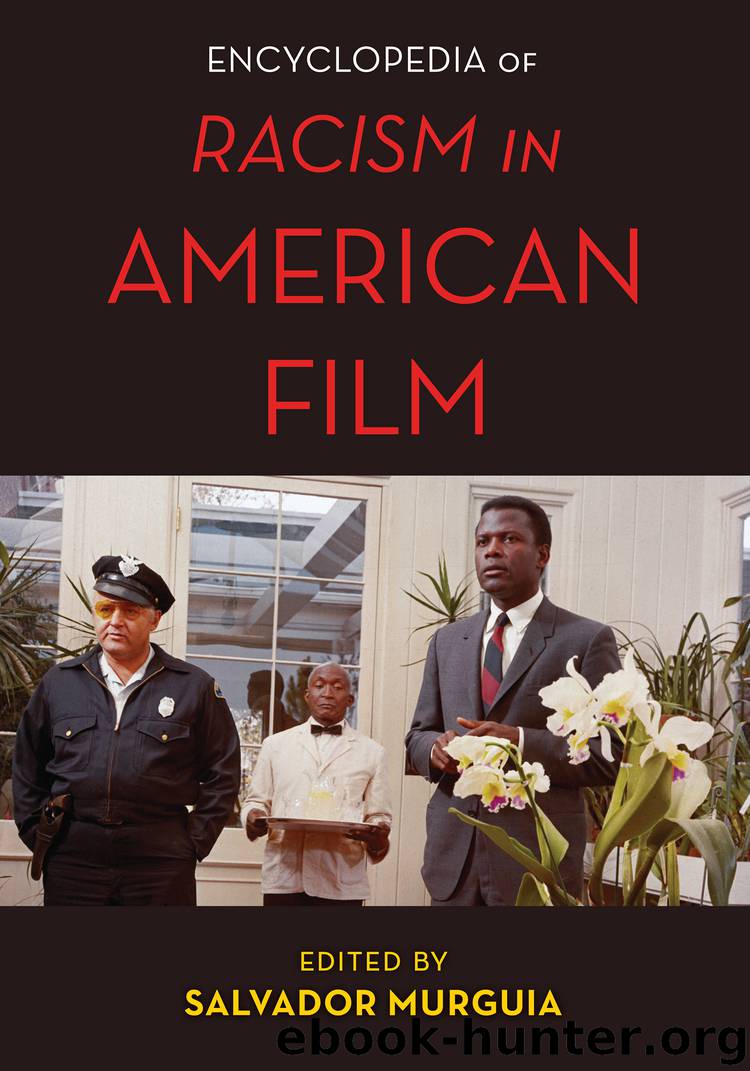The Encyclopedia of Racism in American Films by Salvador Jimenez Murguía

Author:Salvador Jimenez Murguía [Murguía, Salvador Jimenez]
Language: eng
Format: epub
Publisher: Rowman & Littlefield Publishers
Published: 2018-03-22T16:00:00+00:00
Denzel Washington and Spike Lee. 40 Acres and a Mule Filmworks / Universal Pictures / Photofest © 40 Acres and a Mule Filmworks / Universal Pictures
Indigo and Clarke symbolize a classic divide between “good girl” and “bad girl” stereotypes, which is reinforced by the racialized features. Indigo is a teacher who wears her hair natural; Clarke is an aspiring singer, with straightened hair and light skin. Indigo seeks an emotional connection with Bleek; Clarke is only in it for the sex and the possibility of a gig. One reviewer accurately describes them as “particularly thin cardboard” (Page 1990), and another echoes this sentiment, describing the women as “pathetically shallow” (James 1990). The only other female character is a white French woman who is dating one of the band members, “Left Hand Lacey.” In a heated backstage conversation, the band members chastise Left Hand Lacey for being late, and he accuses them of being mad because he is dating a white woman. The other band members laugh when he calls her a sister, and one responds by placing a picture of a nude, dark-skinned black woman on the mirror, saying this woman is a “queen.” The stereotypes continue when Bleek discusses his predicament with his father, who merely responds with a diatribe about unmarried black girls having children. Once again, the film presents viewers with a stereotype that goes unchallenged by the film or its characters.
Perhaps the most egregious stereotype, however, is in the film’s portrayal of two Jewish club owners, “Moe” (John Turturro) and “Josh Flatbush” (Nicholas Turturro). They are portrayed not only as exploitive but utterly uncaring. Moe and Josh refuse to give the band a raise, despite the high prices that people pay to see them perform. As Giant and Bleek lay bleeding outside the club, the club owners tell the rest of the band to get back on stage. The Anti-Defamation League described their characterization as anti-Semitic, and many reviewers agreed. Lee responded, comparing the Flatbushes’ 10 minutes of camera time to the 100 years of stereotyping of African Americans in cinema.
Although many film critics panned the film as clichéd and stereotypical, it’s not without its accolades: the Venice Film Festival awarded Lee with a Bastone Bianco Award (Special Mention) and nominated him for the Golden Lion; several performers won Young Artist Awards in 1992, and the soundtrack, with music from Terence Blanchard, was nominated for the Soul Train Music Award, for Top Jazz Album of 1990.
See also Do the Right Thing; Jackson, Samuel L. (Appendix B); Lee, Spike (Appendix B); Turturro, John (Appendix B); Washington, Denzel (Appendix B)
Bibliography
James, Caryn. “Critic’s Notebook; Spike Lee’s Jews and the Passage from Benign Cliché into Bigotry.” New York Times. 1990. http://www.nytimes.com/1990/08/16/movies/critic-s-notebook-spike-lee-s-jews-passage-benign-cliche-into-bigotry.html?pagewanted=all (December 2, 2015).
Page, Clarence. “From Spike Lee, Some Unfortunate Stereotyping.” Chicago Tribune. 1990. http://articles.chicagotribune.com/1990–08–29/news/9003120922_1_stereotypes-with-sharks-smiles-white-filmmakers-mo-better-blues (April 4, 2016).
—Jessica McKee
Monster’s Ball (2001)
Director: Marc Forster
Screenplay: Milo Addica and Will Rokos
Specs: 131 minutes; color
Monster’s Ball is a 2001 drama by Marc Forster that tells the story of a white prison guard
Download
This site does not store any files on its server. We only index and link to content provided by other sites. Please contact the content providers to delete copyright contents if any and email us, we'll remove relevant links or contents immediately.
| General | Discrimination & Racism |
Nudge - Improving Decisions about Health, Wealth, and Happiness by Thaler Sunstein(6629)
iGen by Jean M. Twenge(4693)
The Fire Next Time by James Baldwin(4336)
Adulting by Kelly Williams Brown(3663)
The Sports Rules Book by Human Kinetics(3581)
The Hacking of the American Mind by Robert H. Lustig(3575)
The Ethical Slut by Janet W. Hardy(3494)
Captivate by Vanessa Van Edwards(3292)
Mummy Knew by Lisa James(3164)
In a Sunburned Country by Bill Bryson(2941)
Ants Among Elephants by Sujatha Gidla(2920)
The Worm at the Core by Sheldon Solomon(2910)
Suicide: A Study in Sociology by Emile Durkheim(2606)
The Slow Fix: Solve Problems, Work Smarter, and Live Better In a World Addicted to Speed by Carl Honore(2570)
Humans of New York by Brandon Stanton(2376)
Handbook of Forensic Sociology and Psychology by Stephen J. Morewitz & Mark L. Goldstein(2376)
Blackwell Companion to Sociology, The by Judith R. Blau(2314)
The Happy Hooker by Xaviera Hollander(2271)
Outliers by Malcolm Gladwell(2254)
